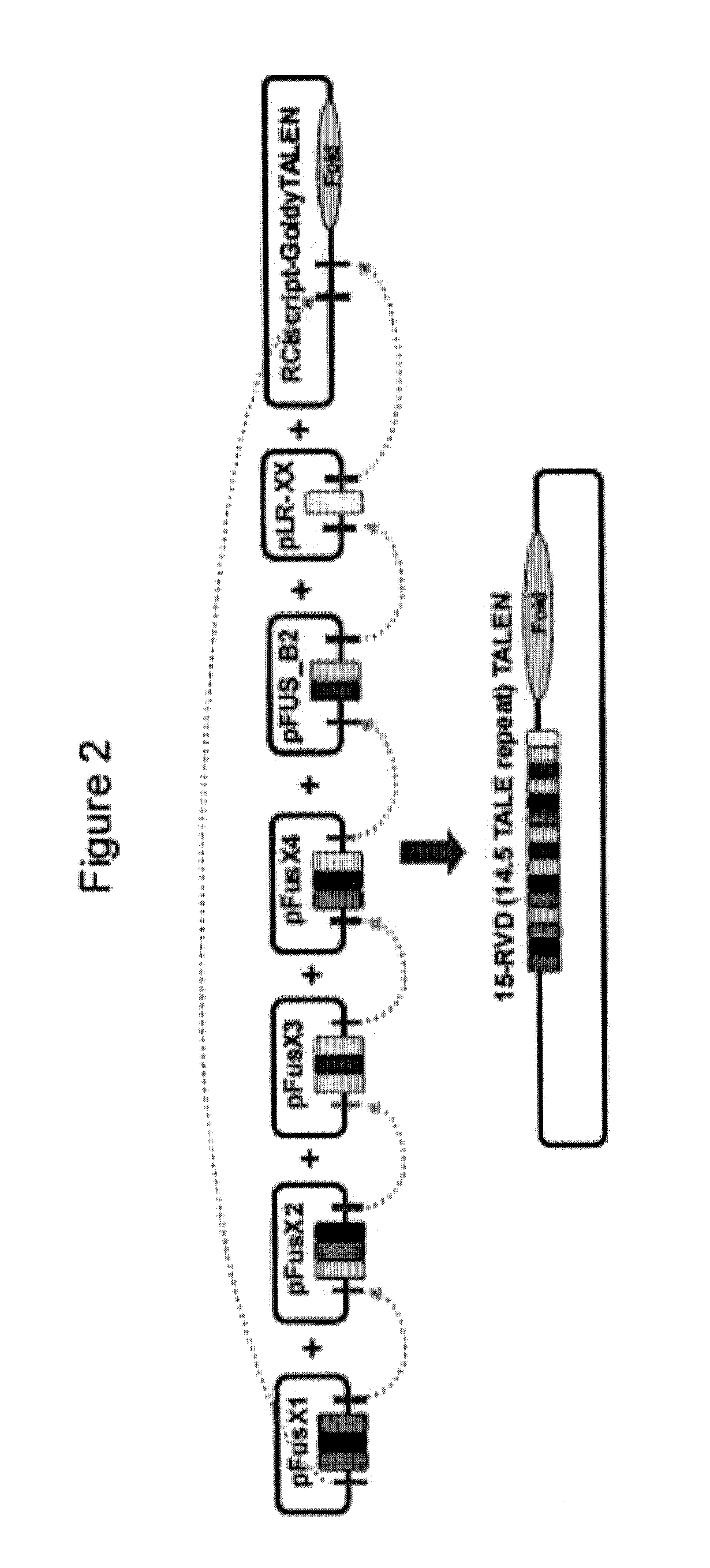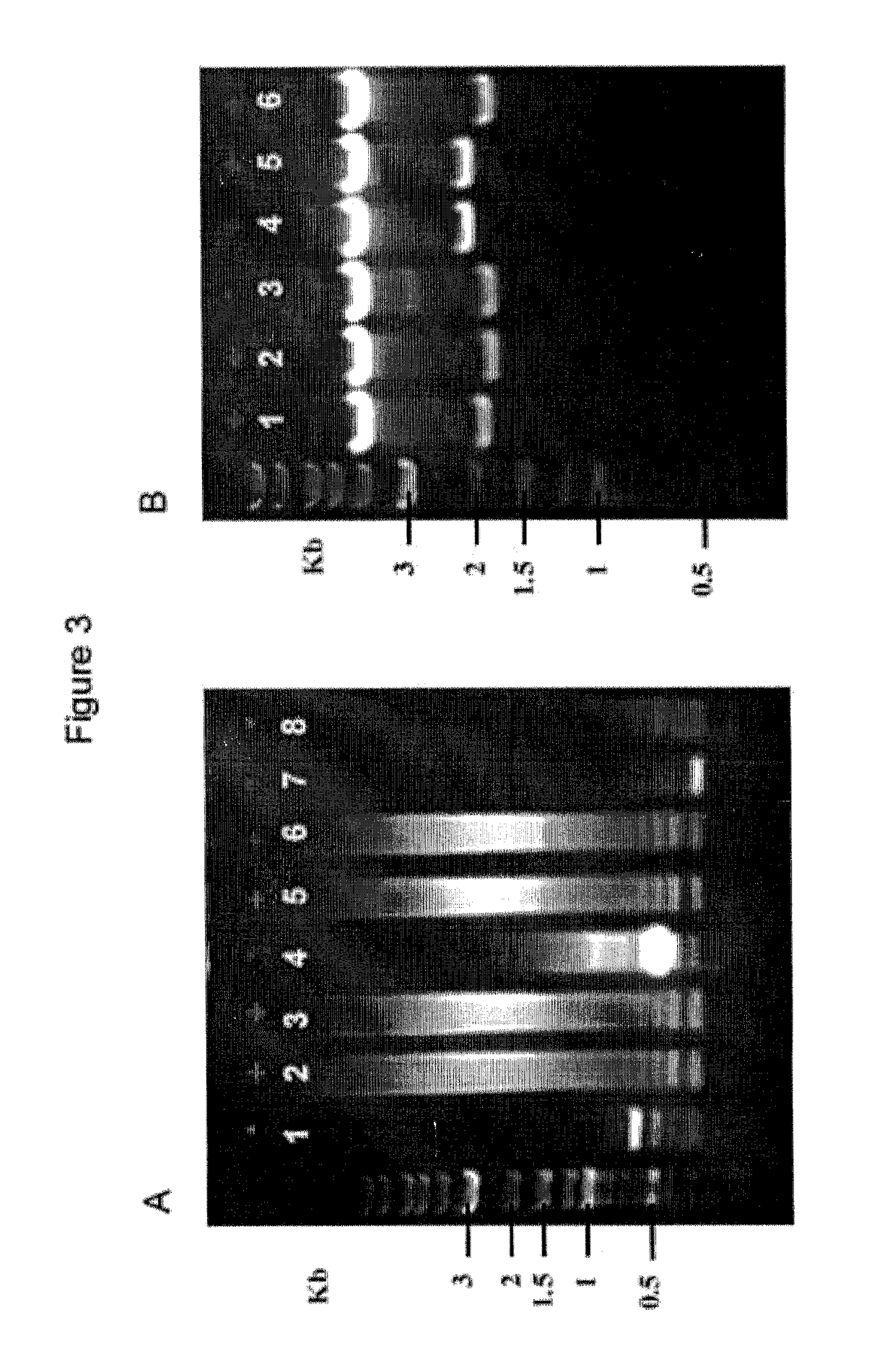Methods and materials for assembling nucleic acid constructs
- Summary
- Abstract
- Description
- Claims
- Application Information
AI Technical Summary
Benefits of technology
Problems solved by technology
Method used
Image
Examples
example 1
apid One-Step Golden Gate TALE Assembly System for Genome Science
Generating the FusX TALE Assembly System
[0037]Modification of Tandem TALE Intermediate Assembly Vectors: pFusX1-pFusX4
[0038]No modifications were required to generate pFusX1, which is the same as the original GGT kit assembly vector, pFus_A30A. The assembly vectors, pFusX2, pFusX3 and pFusX4 (X2, X3 and X4) were modified from pFus_A30B of the original GGT kit (Cermak et al., Nucleic Acids Res., 39:e82 (2011)). Modifications to pFusA_30B were made via removal of a small fragment using different restriction endonuclease combinations for each assembly vector X2, X3 or X4. These sequence fragments were replaced with modified short oligonucleotides to generate specific four-base overhangs upon BsmBI digestion (Table 1 and 2). The nature of the specific BsmBI overhangs allows the pFusX components to be assembled in tandem into the final TALE array (FIG. 1). For pFusX2, the replacement oligonucleotide fragment was produced by...
example 2
Programming TALENs Using an Accessible Laboratory Automation Tool, OpenTrons
[0067]All 64 RVD plasmids of each pFusX1-pFusX4 trimer library were organized by columns (starting with column A) into four 96-well plates (FIG. 5D). An additional 96-well plate was used to store the 64 pFus_B3 RVD and the 16 pFus_B2 RVD plasmids. The RVD plasmids were mapped onto the appropriate plate in alphabetical order of the nucleotide sequence of their target recognition site (i.e. AAA, AAC, AAG, AAT, ACA, ACC, and so on). A sixth 96-well plate was used to store aliquots of the 4 pLR plasmids in the same alphabetical order as above, the GoldyTALEN receiver plasmid, and the 10× Buffer 3.1 (NEB) from well A1 (NI pLR plasmid) to F1(10× Buffer 3.1) accordingly. An OT.One Opentrons LHR (firmware v1.0.0pipy, FIG. 5A), running on a Raspberry Pi 2 singleboard computer (Raspbian GNU / Linux 8.0 (jessie)) and a Smoothieboard 5x numerical controller (SmoothiewareOT v1.0.5, FIG. 5A.2), was set up to handle a 10μ.DR...
PUM
| Property | Measurement | Unit |
|---|---|---|
| Volume | aaaaa | aaaaa |
| Volume | aaaaa | aaaaa |
| Volume | aaaaa | aaaaa |
Abstract
Description
Claims
Application Information
 Login to View More
Login to View More - R&D Engineer
- R&D Manager
- IP Professional
- Industry Leading Data Capabilities
- Powerful AI technology
- Patent DNA Extraction
Browse by: Latest US Patents, China's latest patents, Technical Efficacy Thesaurus, Application Domain, Technology Topic, Popular Technical Reports.
© 2024 PatSnap. All rights reserved.Legal|Privacy policy|Modern Slavery Act Transparency Statement|Sitemap|About US| Contact US: help@patsnap.com










